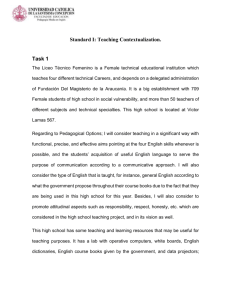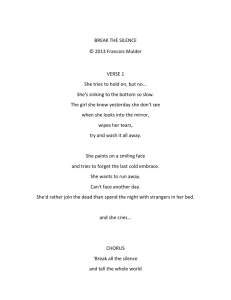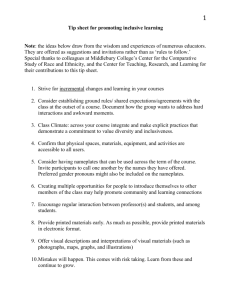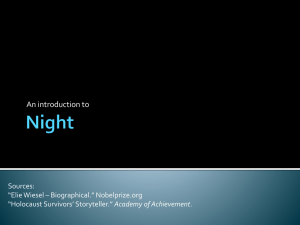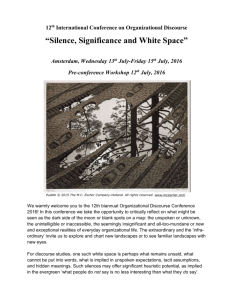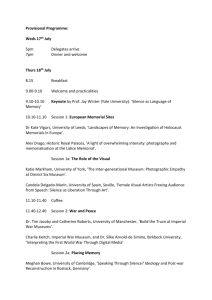Article template - Russian Linguistic Bulletin
advertisement
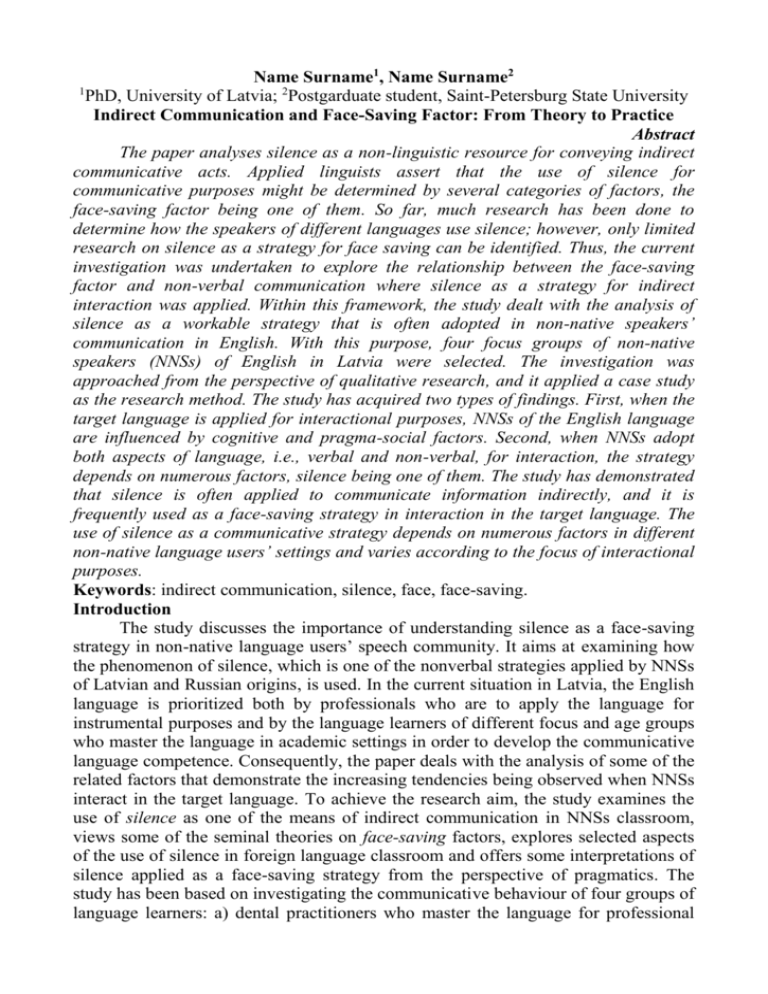
Name Surname1, Name Surname2 1 PhD, University of Latvia; 2Postgarduate student, Saint-Petersburg State University Indirect Communication and Face-Saving Factor: From Theory to Practice Abstract The paper analyses silence as a non-linguistic resource for conveying indirect communicative acts. Applied linguists assert that the use of silence for communicative purposes might be determined by several categories of factors, the face-saving factor being one of them. So far, much research has been done to determine how the speakers of different languages use silence; however, only limited research on silence as a strategy for face saving can be identified. Thus, the current investigation was undertaken to explore the relationship between the face-saving factor and non-verbal communication where silence as a strategy for indirect interaction was applied. Within this framework, the study dealt with the analysis of silence as a workable strategy that is often adopted in non-native speakers’ communication in English. With this purpose, four focus groups of non-native speakers (NNSs) of English in Latvia were selected. The investigation was approached from the perspective of qualitative research, and it applied a case study as the research method. The study has acquired two types of findings. First, when the target language is applied for interactional purposes, NNSs of the English language are influenced by cognitive and pragma-social factors. Second, when NNSs adopt both aspects of language, i.e., verbal and non-verbal, for interaction, the strategy depends on numerous factors, silence being one of them. The study has demonstrated that silence is often applied to communicate information indirectly, and it is frequently used as a face-saving strategy in interaction in the target language. The use of silence as a communicative strategy depends on numerous factors in different non-native language users’ settings and varies according to the focus of interactional purposes. Keywords: indirect communication, silence, face, face-saving. Introduction The study discusses the importance of understanding silence as a face-saving strategy in non-native language users’ speech community. It aims at examining how the phenomenon of silence, which is one of the nonverbal strategies applied by NNSs of Latvian and Russian origins, is used. In the current situation in Latvia, the English language is prioritized both by professionals who are to apply the language for instrumental purposes and by the language learners of different focus and age groups who master the language in academic settings in order to develop the communicative language competence. Consequently, the paper deals with the analysis of some of the related factors that demonstrate the increasing tendencies being observed when NNSs interact in the target language. To achieve the research aim, the study examines the use of silence as one of the means of indirect communication in NNSs classroom, views some of the seminal theories on face-saving factors, explores selected aspects of the use of silence in foreign language classroom and offers some interpretations of silence applied as a face-saving strategy from the perspective of pragmatics. The study has been based on investigating the communicative behaviour of four groups of language learners: a) dental practitioners who master the language for professional purposes in order to communicate with their patients of foreign origin, b) learners who do their academic studies at the University of Latvia and who do their professional studies in the Vocational School and at Riga Technical College. Fig. 1 – Digital Ultra Thus, the study has posed the following research question: How does silence function as a face-saving strategy when NNSs use the English language for communicative purposes in Latvia? Theoretical Background of Study The theoretical background of the present study is established considering selected theoretical contributions on investigation of silence as a strategy for indirect communication and it is backed up by the analysis of some of the seminal writings on face-saving that deal with the study of face when it is used to refer to the public image of a language user. Table 1 – optimum parameters № Category TS % Speed 1 a 22-24 40-60 0,1 2 b 23-25 40-60 0,1 Silence - Strategy for Indirect Communication Silence does not merely function as a ‘background’ to speech. It, in fact, is considered to be a complex, multifaceted and powerful element of human interaction. In recent years, there has been a growing research interest in exploring the role of silence in communication (e.g. Nakane, 2007). The recent study has demonstrated so far that the notion silence is used to refer to various phenomena, ranging from the absence of any noise to brief almost inaudible silences (pauses) within or between speech turns (Sifiniaou, cited in Jaworski, 1997, p. 63). Besides, silence can exist without speech, but speech cannot exist without silence. Silence establishes its meaning only in verbal or nonverbal contexts (Johannesen, cited in Jaworski, 1997, p. 44). Applied linguists have indicated that silence is not simply an absence of noise but it constitutes a part of communication that is as important as speech (e.g., Jaworski 1997; Sacks et al. 1974; Tannen & Saville-Troike 1985; Nakane, 2007, p. 5) The contradictory nature of silence indicates its complex and context-dependent role in communication. Nakane (2007), for example, states that while the linguistic strategy of questioning in one-to-one communicative situations gives power to the questioner, the respondent can reverse the situation by refusing to give a response (Nakane, 2007, p. 9-10). Besides, silence can be, or can seem to be the result of personal choice; however, silencing involves choices made by other people as well as the choices prioritized by the speaker himself/herself. According to Thiesmeyer (2003), the action of silencing is accompanied by social, political, and cultural References 1. Barron, A. (2002). Acquisition in Interlanguage Pragmatics: Learning How to Do Things With Words in a Study Abroad Context. Amsterdam: John Benjamins 2. Blimes, J. (1994). Constituting Silence: Life in the World of Total Meaning. Semiotica. 98(1/2): 73-78 3. Brown, P. and Levinson, S. (1978). Language Usage: Politeness Phenomena. In: E.G. Goody (ed.) Questions and Politeness: Strategies in Social Interaction. Cambridge: Cambridge University Press 4. Brown, P. and Levinson, S.D. (1987) Politeness: Some Universals in Language Usage. Cambridge: Cambridge University Press 5. Brown, G. and Yule, G. (1983). Discourse analysis. Cambridge: Cambridge University Press. 6. Bruneu, T. J. (1973). Communicative Silence: Forms and Functions. The Journal of Communication, 23: 17-46 7. Boyacigileer, N. A., Kleinberg, J., Philips, M.A., Sackmann, S.A. (2004). Conceptualizing Culture. In Punnett, B.J., Shenkar. O (eds) Handbook for International Management Research. Michigan: University of Michigan Press, 99-167 8. Common European Framework of References for Languages (2001). Strasburg. 9. Fraser, B. (1990). Perspectives on Politeness. Journal of Pragmatics, 14(2): 219- 236 10. Grundy, P. (1995). Doing Pragmatics. University of Durham: Arnold 11. Hall, E. (1992) An Antropology of Every Day. New York: Doubleday 12. Jaworski, A. (1993). The Power of Silence: Social and Pragmatic Perspectives. London: Sage 13. Jaworski, A. (1997) Silence: Interdisciplinary Perspectives. Berlin: Walter de Gruyter. 14. Jaworski, A. , Galasinski, D. (2000). Strategies of Silence: Omission and Ambiguity in Black Book of Polish Censorship. Semiotica (131 (1/2): 185-200 15. Liu, J. (2002) Negotiating Silence in American Classroom: Three Chinese Cases. Language and Intercultural Communication, 2(1): 37-54 16. LoCastro, V. (2006). An Introduction to Pragmatic. Michigan: The University of Michigan Press. 17. Nakane, I. (2007) Silence in Intercultural Communication. Amsterdam/ Philadelphia: John Benjamins 18. Sacks, H., Schegloff, E. A. and Jefferson, G. (1974) A Simplest Systematics for the Organization of Turn-taking for Conversation. Language. 50 (4): 696-735. 19. Saunders, G.R. (1985). Silence as Cultural Pedagogical Performance: Possibilities in Silence Research, London: Routledge 20. Saville-Troike, M. and Tannen, D. (1985). Perspectives on Silence. Norwood, N.J.: Ablex 21. Sobkowiak, W. (1997) Silence and Markedness Theory. In A. Jaworski (ed.) Silence: Interdisciplinary Perspectives, Berlin: Moyton de Gryter, 63-84 22. Sugito, M. (1991). Discourse Analysis: Speech and Pause. Japanese Linguistics,10: 19-30 23. Thiesmeyer, J. L. (ed.) (2003). Discourse and Silencing. Representation and the Language of Displacement. Amsterdam/ Philadelphia: John Benjamins. 24. Walker, A.G. (1985). The Two Faces of Silence. In D. Tannen and M. Saville-Troike (eds.) Perspectives on Silence. Nowood: NJ Ablex, 55-75
